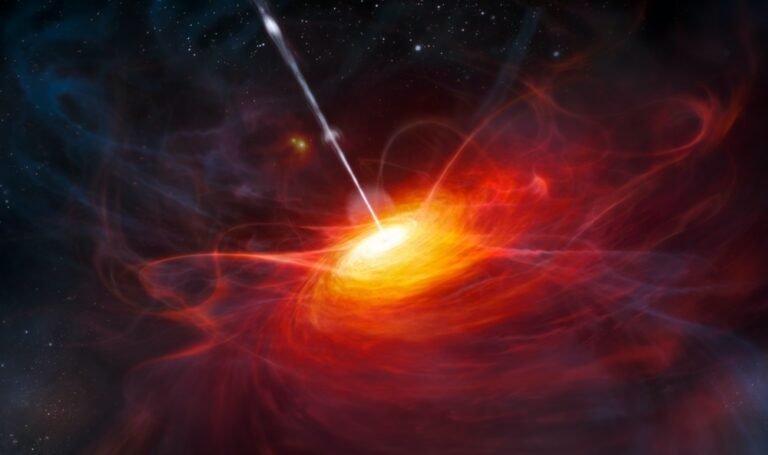Back in 2019, scientists were given their first glimpse of a supermassive black hole, a mainstay in our understanding of the physics of the universe, with the help of radio imagery collected and processed by the Event Horizon Telescope Collaboration. The black hole, estimated to be millions of times the mass of our sun, rests at the center of a distant galaxy called M87, and the appearance of the collaboration’s images of it in science publications two years ago marked a significant milestone in the advancement of modern physics.
Now, a team of scientists have published a pair of papers in The Astrophysical Journal Letters, with a third currently pending peer review, marking the second batch of images of M87’s cosmic monster. In the images, polarized light seen around the black hole now helps to provide astronomers with clues about the behavior of its magnetic field.
One of the most widely discussed phenomena in all the known cosmos, black holes are regions of space where gravity is so intense that nothing is able to escape it, not even light.
As far back as April 2017, the near-horizon region encircling M87’s black hole was observed using the Event Horizon Telescope, which was able to detect the 1.3-millimeter wavelength observations that helped to reveal the black hole’s asymmetrical ring-like shape. It was noticed that the asymmetry of the black hole appeared to be on account of highly polarized region on one part of the hole’s “ring.”
In the new observations, the Event Horizon Telescope Collaboration has released its corresponding imagery from the Event Horizon Telescope (EHT) which displays this polarized region of the black hole.


Emitted from the core of the supermassive black hole at the center of M87 are jetlike plumes of matter, which race away from the superdense region at close to the speed of light. These jets are able to extend well beyond M87, allowing astronomers to detect them which aids in visualizing the magnetic properties of the black hole itself.
Andrew Chael, an astronomer at the Princeton Center for Theoretical Science and one of the researchers with the Event Horizon Telescope Collaboration, called the new images “key to understanding how the magnetic field allows the black hole to ‘eat’ matter and launch powerful jets.”
“When you measure light emanating from an astronomical source, sometimes some of it is polarized,” Chael said in a statement, which he likened to light passing through a pair of polarized sunglasses.
“Instead of lenses, though, it is magnetic fields in hot regions of space that polarize astronomical light,” Chael says. “Thus, using telescopes to measure how the light is polarized will give you direct information about the magnetic fields that caused it.”
These new observations, the researchers believe, show that the magnetic fields produced by M87’s supermassive black hole are strong enough, in fact, that they actually allow hot gases to escape and overcome its incredible gravitational pull.
“The observations suggest that the magnetic fields at the black hole’s edge are strong enough to push back on the hot gas and help it resist gravity’s pull,” explains Jason Dexter, Assistant Professor of Astrophysics at the University of Colorado, Boulder and one of the several contributing coauthors of the new papers.
“Only the gas that slips through the field can spiral inwards to the event horizon,” Dexter says.
The research that produced the new imagery relied on several different image modeling techniques, which the researchers were able to help validate with synthetic data sets in order to ensure its accuracy.


M87, the galaxy that serves as the cosmic “nest” of this supermassive black hole, is what astronomers call a supergiant elliptical galaxy. As far as nearby galaxies, it is one of the most massive, and has long been an area of focus for astronomers. First discovered in 1781 by Charles Messier (the galaxy borrows its official name, Messier 87, from the French astronomer), it was originally classed as a nebula. Today, M87 is recognized as the second-brightest galaxy observable in the constellation of Virgo.
The Event Horizon Telescope Collaboration team hopes that the new polarized-based images it has been able to generate of M87’s supermassive black hole may be useful in helping determine the forces that drive quasars, the very bright active galactic nucleus, or AGN, which surrounds supermassive black holes.
The latest research by the Event Horizon Telescope Collaboration appeared in The Astrophysical Journal Letters. The first two of three papers papers detailing the team’s research can be found online here and here, and more information about the Collaboration can be found at its website.
Follow and connect with author Micah Hanks on Twitter: @MicahHanks
Don’t forget to follow us on Twitter, Facebook, and Instagram, to weigh in and share your thoughts. You can also get all the latest news and exciting feature content from The Debrief on Flipboard, and Pinterest. And subscribe to The Debrief YouTube Channel to check out all of The Debrief’s exciting original shows: The Official Debrief Podcast with Michael Mataluni– DEBRIEFED: Digging Deeper with Cristina Gomez –Rebelliously Curious with Chrissy Newton


